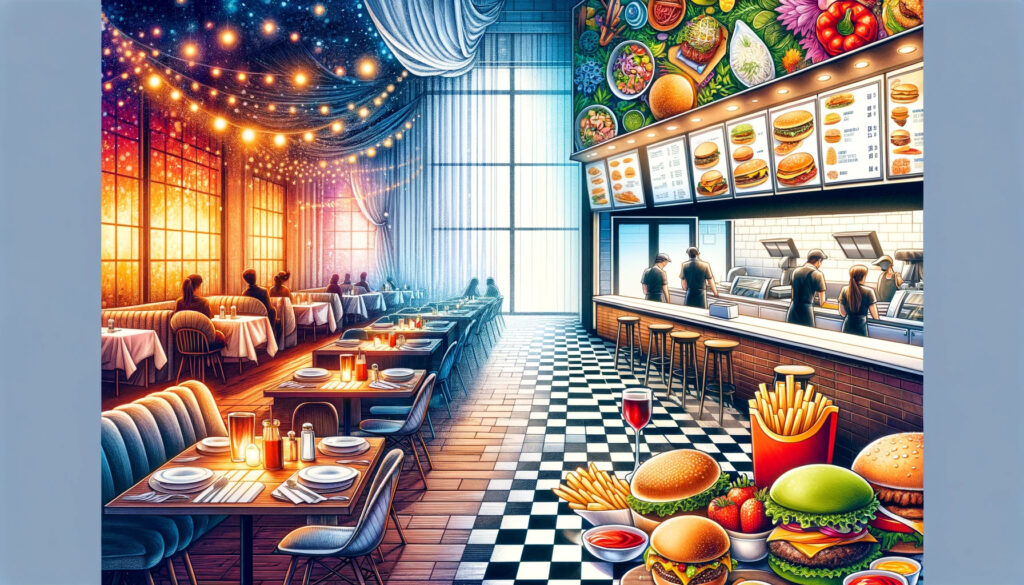In today’s fast-paced world, food choices are often dictated by convenience and taste. The dining landscape is dominated by two primary players: fast food outlets and traditional restaurants. This blog post delves into the nuances that differentiate these two dining experiences, aiming to clarify misconceptions and offer insights into their unique characteristics.
Defining Fast Food and Restaurants
Fast Food: Characterized by its speed of service, fast food is typically served at quick-service outlets. It’s defined by pre-prepared items or easy-to-cook meals, served swiftly to customers, often in disposable packaging.
Restaurants: These establishments offer a sit-down dining experience, where food is freshly prepared after an order is placed. Restaurants are known for their varied menus, ambient settings, and customer service that extends beyond mere food delivery.
Key Differences
Service Style
Fast food is synonymous with efficiency and speed. Customers expect quick service, often through drive-thrus or counter ordering. In contrast, restaurants focus on a more relaxed, sit-down service where patrons are waited upon at their tables.
Menu Options
Fast food menus are typically limited and standardized, offering consistency across various locations. Restaurants, however, boast diverse menus, often inspired by specific cuisines, with options that can be customized to individual preferences.
Food Preparation
The preparation in fast food outlets is geared towards speed and uniformity, often using pre-prepared ingredients. Restaurants pride themselves on fresh ingredients and made-to-order meals, emphasizing culinary skills and flavor.
Price Points
Generally, fast food is more wallet-friendly, catering to those seeking quick, budget meals. Restaurants, with their extensive service and quality ingredients, often command higher prices.
Quality and Health Aspects
Fast food has long been criticized for its high caloric content and lower nutritional value, largely due to mass production and usage of preservatives. Restaurants, especially those focusing on fine dining, tend to offer healthier options, with attention to ingredient quality and balanced nutrition.
Ambiance and Dining Experience
The ambiance of fast food outlets is functional and casual, designed for quick dining or takeaway. Restaurants offer a varied atmosphere, from casual to upscale, focusing on creating a dining experience that extends beyond just eating.
Target Audience and Marketing
Fast food targets customers seeking convenience and speed, often appealing to younger demographics and busy professionals. Restaurants cater to a more diverse audience, from families enjoying a night out to individuals seeking a fine dining experience.
Impact on Culture and Society
Fast food has significantly influenced modern lifestyles, promoting on-the-go eating habits. Conversely, restaurants have fostered dining as a social activity, contributing to the culinary arts and cultural diversity.
Advantages and Disadvantages
Fast food offers convenience and affordability but often at the cost of health and quality. Restaurants provide a richer culinary experience and healthier options but can be time-consuming and more expensive.
| Aspect | Fast Food | Restaurant |
|---|---|---|
| Service Style | Quick service, often drive-thru or counter ordering. | Sit-down service with table service. |
| Menu Options | Limited and standardized menu. | Diverse and often customizable menu. |
| Food Preparation | Pre-prepared or quickly cooked meals. | Freshly prepared meals, often cooked to order. |
| Price Point | Generally more affordable. | Usually more expensive, varies by restaurant type. |
| Nutritional Value | Often high in calories and lower in nutritional value. | Typically offers healthier options. |
| Ambiance | Functional and casual, designed for quick dining. | Varied, from casual to upscale, focusing on experience. |
| Target Audience | Customers seeking convenience and speed. | Diverse, from families to fine dining enthusiasts. |
| Cultural Impact | Promotes on-the-go eating habits. | Fosters dining as a social activity. |
| Pros | Convenient, quick, and budget-friendly. | Richer culinary experience, healthier options. |
| Cons | Lower food quality, potential health concerns. | More time-consuming, higher cost. |
While both fast food and restaurants serve the fundamental purpose of feeding people, they cater to different needs and expectations. Understanding these differences helps consumers make informed choices based on their preferences, time, and budget.
What are your preferences when it comes to dining out? Do you prioritize convenience or the dining experience? Share your thoughts and experiences in the comments below.

